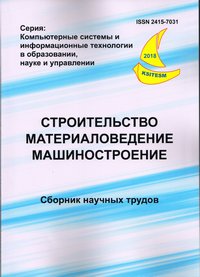Hypermedia training system «architecture of civil and public buildings»
DOI:
https://doi.org/10.30838/P.CMM.2415.270818.45.228Keywords:
training system, hypertext database, hypermedia system, architecture, civil and public buildings, information models of layoutsAbstract
Purpose of the article. It has been established that a user of computer-aided design (CAD) can effectively solve his tasks only with the active help of a computer. An additional means of enhancing the user's cognitive activity are automatic training system (ATS). They are a complex of software-hardware and educational tools that provide active individual assistance to the user. All people over the world are engaged in the development of such systems nowadays. Therefore, the task of creating CAD training is relevant. The hypermedia systems (GM - system) recently appear. It is a system that uses the most advanced technologies and is designed to increase the efficiency and intensify the processes of interaction between a person and the entire knowledge-related environment. The purpose of the work is to explain the basic concepts of hypertext and the functioning of the GM on the example of the training system «Architecture of civil and public buildings». Methodology of the research. The concepts of elements of the hypertext architecture are given: node, connection, system model, and hypertext database. A brief description of the hypermedia educational system «Architecture of civil and public buildings» is given, which contains information models of building layouts and is used in course design. The information model of a two-storey cottage has 12 modules designed for the planning of the building and its individual parts. Results. A hypertext database has been formed, including texts, graphics, calculations, reference data, available technical solutions, video information. Scientific novelty. A hypermedia training system «Architecture of civil and public buildings» was created, which contains information models of building layout. A new philosophy of presentation of the material has been proposed, which makes students learn the world differently and actively participate in the learning process. Practical significance. The training system is used in course design. Training is conducted by a lecturer. Thanks to the visualization, students have the opportunity to present more realistically not only individual, rather complex structural elements and components, but also the technology of construction of the building itself. For clarity, the training process uses educational films that allow students to be on the construction site without leaving the classroom.References
Ageev V.N. Primery gipertekstovykh i gipermediasistem (obzor) [Examples of Hypertext and Hypermedia Systems (Review)] // Kompyuternyye tekhnologii v vysshem obrazovaniyi [ Computer Technologies in Higher Education]. Moscow: MGU, 1994, pp. 225 - 229. (in Russian).
Gavrilova T.A. Zudilova E.V. and Ilyasov M. Z. Intellektualnyye i obuchayushchiye sistemy: Uchebnoe posobie [Intellectual and Learning Systems: Tutorial]. StPb.: State. Tech. University Press, 1996. - 110 p. (in Russian).
Gavrilova T.A. and Khoroshevskiy V.F. Bazy znaniy intellektualnykh sistem: Uchebnik [Knowledge Bases of Intellectual Systems: Textbook]. StPb.: Piter Publ., 2001, 384 p. (in Russian).
Litvin O. E. Tvir naukovogo kharakteru «Usovershenstvovaniye metodiki prepodavaniya kursa «Arkhitektura zhilykh zdaniy kottedzhnogo tipa» s primeneniyem kompyuternoy tekhniki» [The work of a scientific character "Improvement of teaching methods of the course" Architecture of residential buildings of cottage type " using computer technologies"]. Authorship certificate No. 28689 dated 12.05.2009. (in Russian).
Yakubenko A. O programme AutodeskRevit. Vvedeniye. Vozmozhnosti. [About Autodesk Revit. Introduction Opportunities.] Available at: http://sapr-journal/ru/stati/autodesk-revit/ (in Russian).
Nielsen J. HyperText & HyperMedia. Academ. Press Inc, 1990.
Downloads
Published
Issue
Section
License
Редакція Видання категорично засуджує прояви плагіату в статтях та вживає всіх можливих заходів для його недопущення. Плагіат розглядається як форма порушення авторських прав і наукової етики.
При виявлені у статті більш ніж 25% запозиченого тексту без відповідних посилань та використання лапок, стаття кваліфікується як така, що містить плагіат. У цьому випадку стаття більше не розглядається редакцією, а автор отримує перше попередження.
Автори, в статтях яких повторно виявлено плагіат, не зможуть публікуватися в усіх журналах Видавництва ДВНЗ «Придніпровська державна академія будівництва та архітектури».
Автори, які публікуються у цьому журналі, погоджуються з наступними умовами:
- Автори залишають за собою право на авторство своєї роботи та передають журналу право першої публікації цієї роботи на умовах ліцензії Creative Commons Attribution License, котра дозволяє іншим особам вільно розповсюджувати опубліковану роботу з обов'язковим посиланням на авторів оригінальної роботи та першу публікацію роботи у цьому журналі.
- Автори мають право укладати самостійні додаткові угоди щодо неексклюзивного розповсюдження роботи у тому вигляді, в якому вона була опублікована цим журналом (наприклад, розміщувати роботу в електронному сховищі установи або публікувати у складі монографії), за умови збереження посилання на першу публікацію роботи у цьому журналі.
- Політика журналу дозволяє і заохочує розміщення авторами в мережі Інтернет (наприклад, у сховищах установ або на особистих веб-сайтах) рукопису роботи, як до подання цього рукопису до редакції, так і під час його редакційного опрацювання, оскільки це сприяє виникненню продуктивної наукової дискусії та позитивно позначається на оперативності та динаміці цитування опублікованої роботи (див. The Effect of Open Access).

